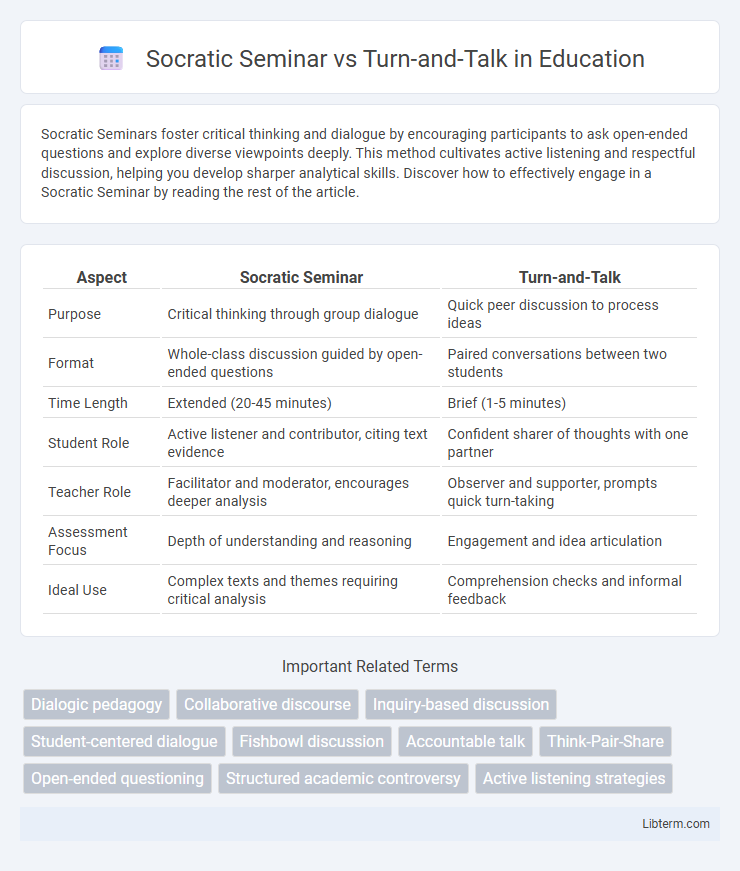Socratic Seminars foster critical thinking and dialogue by encouraging participants to ask open-ended questions and explore diverse viewpoints deeply. This method cultivates active listening and respectful discussion, helping you develop sharper analytical skills. Discover how to effectively engage in a Socratic Seminar by reading the rest of the article.
Table of Comparison
| Aspect | Socratic Seminar | Turn-and-Talk |
|---|---|---|
| Purpose | Critical thinking through group dialogue | Quick peer discussion to process ideas |
| Format | Whole-class discussion guided by open-ended questions | Paired conversations between two students |
| Time Length | Extended (20-45 minutes) | Brief (1-5 minutes) |
| Student Role | Active listener and contributor, citing text evidence | Confident sharer of thoughts with one partner |
| Teacher Role | Facilitator and moderator, encourages deeper analysis | Observer and supporter, prompts quick turn-taking |
| Assessment Focus | Depth of understanding and reasoning | Engagement and idea articulation |
| Ideal Use | Complex texts and themes requiring critical analysis | Comprehension checks and informal feedback |
Introduction to Socratic Seminar and Turn-and-Talk
Socratic Seminar is a structured discussion method rooted in Socratic questioning that encourages deep critical thinking and collaborative dialogue around a central text or topic. Turn-and-Talk is a brief partner-based strategy aimed at promoting quick exchanges of ideas and immediate peer engagement during lessons. Both methods foster student participation but differ in format, with Socratic Seminar emphasizing extended, reflective conversations and Turn-and-Talk focusing on concise, spontaneous interaction.
Defining Socratic Seminar: Principles and Structure
Socratic Seminar is defined by its foundation in open-ended, critical questioning aimed at deepening understanding through collaborative dialogue based on Socratic principles. The structure involves a circle discussion format where participants engage in thoughtful, reflective speaking and active listening without predetermined answers, emphasizing evidence-based reasoning from texts or topics. This method contrasts with Turn-and-Talk by fostering extended discourse and collective inquiry rather than brief, paired exchanges.
Overview of Turn-and-Talk: Key Features
Turn-and-Talk is an interactive discussion strategy where students pair up to share thoughts on a topic for a brief period, promoting active engagement and formative assessment. Key features include structured partner communication, time-limited exchanges, and immediate feedback opportunities that enhance comprehension and verbal articulation. This approach supports diverse learning styles by encouraging every student's voice in a low-pressure environment.
Historical Origins and Educational Context
Socratic Seminar traces its origins to the classical practices of Socrates in ancient Greece, emphasizing dialectical questioning and critical thinking within a formal group discussion format. Turn-and-Talk, emerging from modern classroom strategies in the late 20th century, promotes peer-to-peer dialogue by having students briefly discuss prompts with a partner to increase engagement and comprehension. Both methods support active learning but differ in structure and historical context, with Socratic Seminar rooted in philosophical inquiry and Turn-and-Talk designed for interactive, immediate feedback.
Skills Developed: Critical Thinking vs. Communication
Socratic Seminar enhances critical thinking by encouraging students to analyze complex texts, question assumptions, and engage in reflective dialogue. Turn-and-Talk primarily develops communication skills by promoting concise verbal expression and active listening in a collaborative setting. Both strategies cultivate essential academic competencies but emphasize distinct cognitive and interpersonal abilities.
Classroom Implementation Strategies
Socratic Seminar implementation emphasizes open-ended questioning and student-led dialogue, requiring designated discussion roles and a structured format to encourage critical thinking and deep textual analysis. Turn-and-Talk involves quick, informal paired discussions that enable all students to actively participate and articulate responses, making it ideal for checking understanding and promoting peer interaction throughout lessons. Effective classroom strategies include setting clear expectations, modeling discussions, and using purposeful questions aligned with learning objectives for both methods.
Student Engagement and Participation Levels
Socratic Seminar fosters deep student engagement through structured dialogue that encourages critical thinking and extended responses, promoting higher-level participation and collaborative learning. Turn-and-Talk increases participation by allowing all students to share brief ideas in pairs, providing more equitable speaking opportunities but often resulting in shorter, less nuanced contributions. Both strategies enhance engagement, with Socratic Seminar driving in-depth analysis and Turn-and-Talk supporting frequent, inclusive verbal interaction.
Assessment and Feedback Approaches
Socratic Seminars emphasize formative assessment through open-ended questioning that encourages critical thinking and self-reflection, allowing educators to gauge students' depth of understanding and reasoning skills. Turn-and-Talk facilitates immediate, peer-generated feedback by prompting students to articulate thoughts briefly and clarify ideas in pairs, supporting quick assessment of comprehension and communication. Both methods promote evaluative feedback, but Socratic Seminars focus on analytical dialogue assessment while Turn-and-Talk centers on real-time verbal feedback and collaborative learning.
Advantages and Limitations of Each Method
Socratic Seminar enhances critical thinking and deepens comprehension by encouraging open-ended questioning and group dialogue, though it may limit participation to more vocal students and require extensive preparation. Turn-and-Talk promotes immediate peer interaction and equal participation, facilitating quick idea exchange but often lacks the depth and sustained analysis characteristic of Socratic Seminars. Both methods offer distinct strengths: Socratic Seminars foster in-depth reasoning and collaborative inquiry, while Turn-and-Talk supports rapid idea sharing and scaffolds verbal communication skills.
Choosing the Right Method for Your Classroom
Selecting the appropriate discussion method depends on classroom goals, student engagement levels, and content complexity. Socratic Seminar promotes deep critical thinking and analytical dialogue through open-ended questioning, ideal for exploring complex texts. Turn-and-Talk fosters quick, collaborative exchanges among students, making it effective for formative assessments and building confidence in sharing ideas.
Socratic Seminar Infographic

 libterm.com
libterm.com